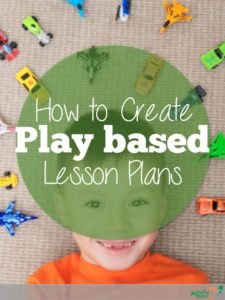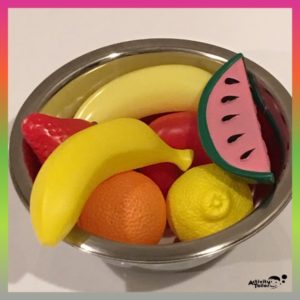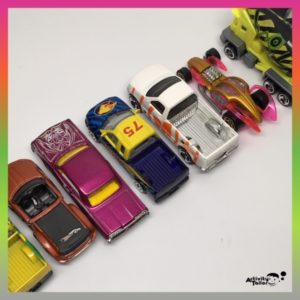
Before we dive right into how to create an effective and fun play-based lesson plan, let’s address a couple of elephants in the room:
- What is play-based speech therapy?
- Who needs play-based speech sessions?
Play-based speech therapy
Play-based speech therapy is PLAY WITH A PURPOSE.
Play-based doesn’t mean you take any toy off the shelf and let the child direct all the action. SLPs have specific goals to target after all, so a bit of advance planning needs to happen.
(Although the more experience you get with this, the faster you’ll be able to adapt nearly any toy to fit your needs.)
To me, a play-based lesson plan means:
- hands-on materials
- consideration for the child’s interests
- child-directed with adult guidance
Who needs play-based sessions?
Toddlers, preschoolers, and even older elementary-aged students can benefit from play-based sessions!
I can’t tell you how many SLPs people, tell me that little ones make them nervous. The two to four year old group is so unpredictable. They have those teeny, tiny attention spans.
Some of our older students can be a bit like this too. They are often developmentally delayed and skittish around activities that look like the classroom ones they struggle with. These students need an approach that excites them but doesn’t make them feel like they’re “working”.
They need therapy that looks more like our toddler/preschool students but they don’t want to feel “babied”.
We need to play! But play with a purpose.
…Okay, so now that those two big questions are out of the way, let’s talk about how to actually create play-based therapy that WORKS.
How to plan a play-based session
Follow these steps when building play-based lesson plans:
- Consider the student’s goals
- Determine what toys you will use
- Brainstorm various play options with these toys
I know, it seems a little vague and somewhat daunting, but it really doesn’t have to be hard!
Let’s talk through some examples of these steps for different types of speech and language goals. I promise, you’ll feel like a rockstar before you know it.
Sessions for speech sound disorders
When I’m working on articulation or phonological processing goals, I almost always start with a list of the target words I want to work on.
For instance, if a student’s goals target multisyllabic words I brainstorm or do a quick online search for words that fit my criteria. Once I have that in hand, I start to group words that might go together.
Foods are one of those categories that easily lend themselves to multisyllabic words. So much so, you can get even more specific—fruits for example. Check out this set of play foods if you don’t have a set already!
*As an Amazon Associate I earn from qualifying purchases.
So let’s imagine we’ve come up with a list of three-syllable fruits: banana, clementine, papaya, apricot, cantaloupe, honeydew, strawberry, blueberry, pineapple, raspberry. Now I can come up with some activities that incorporate these fruits.
Play-based ideas with these words could be:
- make (pretend) smoothies
- cook (pretend) pies to “sell” at a pie stand or serve at a tea party
- make a (pretend) fruit salad to feed to a doll or stuffed animal
- pretend our room is a farm/garden and collect the fruit (like a scavenger hunt)
- use Play-doh to make each fruit
- play farmers market/grocery store and shop for the fruits
- have a bumblebee or butterfly (more 3 syllables!) come to nibble on each fruit
Look how many options we have. We can use the same words and most of the same materials!
Sessions for language delays
Language goals tend to be more flexible. You can start with the toys you have on hand from a previous session or use what the child enjoys.
Again, start by thinking about what the child’s target is. Let’s pick prepositions this time—and what they will play with—Hot Wheels and only Hot Wheels. So…. we could:
- make a car wash and have cars line up behind each other to go through; use brushes can scrub under and on top of the cars
- create an off-road race track where the cars go over big bumps, under bridges, through tunnels, and beside cliffs
- have a high-speed chase where the police cars follow behind the bad guys. The bad guys can hide behind/under/next to buildings and the police can search through the city
- line the cars up beside or behind one another for a car show (or have them parking in a large parking lot)
- pretend to be mechanics and look under the car or hood for areas that need repair
This list would give you several sessions worth of play with the same materials! You would be able to target the same goals even if you varied the actual activity itself.
Does this get you more excited about pulling the toys off your shelf? I hope so! Let me know what you think and if you think you might try one of the ideas when you plan your next play-based speech session.
Are you interested in learning more about Putting Play to Work? Register for my on-demand, 5 star webinar!







